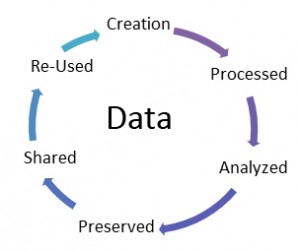This is the first article in a six part series which will describe the various aspects of data management planning.
All data has a “lifecycle.” It’s created, processed, analyzed, preserved, shared, and potentially re-used by you or others in the research community.
Data management is the development and execution of policies and procedures to manage data throughout its lifecycle. Such policies and procedures may include using naming conventions for data files, the weekly back-up of data files to an offsite server, or depositing data into an open-access repository.
Your research group may have policies and procedures, formal or informal, regarding data management, but are they enough? You may be thinking: I have never had a problem locating a file on my computer. I publish my results in reputable journals, so I don’t need to share my data anywhere else. I have never lost data due to a hardware malfunction—so why create a formal plan?
At the basic level, having a data management plan (DMP) is just good science. A thorough DMP can not only save time, facilitate personnel transitions, and safeguard your data, but most importantly, it may be a requirement of your funding agency.
In 2011, the National Science Foundation (NSF) implemented the following directive:
“Proposals submitted or due on or after January 18, 2011, must include a supplementary document of no more than two pages labeled “Data Management Plan.” This supplementary document should describe how the proposal will conform to the NSF policy on the dissemination and sharing of research results.”1
In addition to outlining how results and data will be shared, DMPs may include:2
- Types of data to be produced throughout the project
- Standards to be used for data and metadata format and content
- Policies for access including provisions for privacy, confidentiality, and security
- Policies and provisions for re-use, re-distribution, and the production of derivatives
- Long-term plans for archiving and preservation
Other agencies and even journal publishers are following suit, requiring at the very least that procedures to share the data from a study are put into place. Look for the forthcoming data sharing article in this series for more details.
Not sure where to begin? The University of Pittsburgh provides examples of DMPs. Also available is the free resource, DMPTool, which provides step-by-step instructions and guidance for DMPs.
1. “Dissemination and Sharing of Research Results,” National Science Foundation: Where Discoveries Begin, http://www.nsf.gov/bfa/dias/policy/dmp.jsp (16 January 2013).
2. “Chapter II—Preparation Instructions,” National Science Foundation: Where Discoveries Begin, http://www.nsf.gov/pubs/policydocs/pappguide/nsf11001/gpg_2.jsp#dmp (16 January 2013).
~ Melissa Ratajeski
